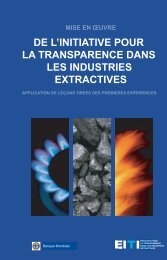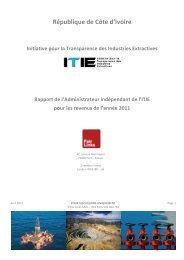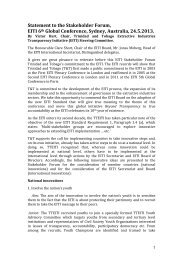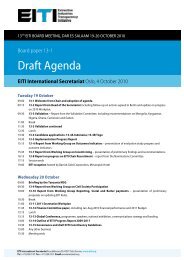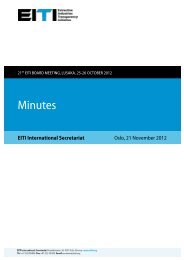Second National Reconcilation Study EITI Peru - unofficial…
Second National Reconcilation Study EITI Peru - unofficial…
Second National Reconcilation Study EITI Peru - unofficial…
Create successful ePaper yourself
Turn your PDF publications into a flip-book with our unique Google optimized e-Paper software.
Consultoría para la Elaboración del Segundo Estudio Nacional de<br />
Conciliación de la Iniciativa de Transparencia para las Industrias<br />
Extractivas (ITIE) en el Perú (2008 – 2010) (continuación)<br />
(iii) We requested additional documentation to that indicated above when we detected differences in<br />
the reconciliation of payments made by companies and the revenues collected by public<br />
institutions.<br />
(iv) We obtained reports from public institutions regarding the distribution of resources collected in<br />
aggregated terms, by geographic areas as well as regional, department, provincial and district<br />
distribution without identifying resource distribution by company except in the case of <strong>Peru</strong>petro,<br />
where the information allows us to identify distribution on a per company basis at the departmental<br />
level and INGEMMET, whose disaggregated information shows distribution by company at the<br />
district level.<br />
3.2. Processing and verifying the information<br />
(i) We systematized the information received on specially designed formats for both the participating<br />
companies and public institutions. These formats can be found in Annexes I to IV of Section X.<br />
When discrepancies were detected, we requested information from the company and/or state entity<br />
in question; where necessary, we requested complementary information only for the point included<br />
in the consultation.<br />
(ii) We reconciled information on the payments made by the companies participating in the <strong>Second</strong><br />
<strong>Study</strong> regarding Income tax, Royalties and Validity Rights and the revenues collected by public<br />
institutions: SUNAT in the case of Income tax and Mining Royalties; <strong>Peru</strong>petro in the case of<br />
Petroleum and Gas Royalties; and INGEMMET in the case of Validity Rights.<br />
(iii) We reviewed the information provided by public institutions to reconcile the revenue collected for<br />
the aforementioned concepts and the contributions distributed by the corresponding public<br />
institutions: DGDFAS-MEF (formerly DGAES-MEF) and PCM in the case of Income tax and Mining<br />
Royalties; <strong>Peru</strong>petro and PCM in the case of Hydrocarbon and Gas Royalties; and INGEMMET in<br />
the case of Validity Rights.<br />
(iv) With regard to income tax (Mining Canon) and Mining Royalties, it is not possible to reconcile the<br />
revenues collected by public institutions (from companies participating in the <strong>Study</strong>) with the<br />
amounts distributed given that these amounts are presented in an aggregated manner by<br />
geographic zones and not broken down by company. We have recalculated to evaluate the<br />
reasonability of distribution for these concepts. In the case of Hydrocarbons, the information<br />
provided by <strong>Peru</strong>petro allowed us to review the distribution of the oil canon and sobrecanon (royalty<br />
surtax) by company only at the district level. In section VII “Details on the results of the<br />
Reconciliation <strong>Study</strong> on Distribution,” we explain the particularities of the distributed concepts as<br />
well as the work done to show the results of the companies’ distribution.<br />
Consultoría para la Comisión Multisectorial Permanente de la ITIE Perú<br />
33




